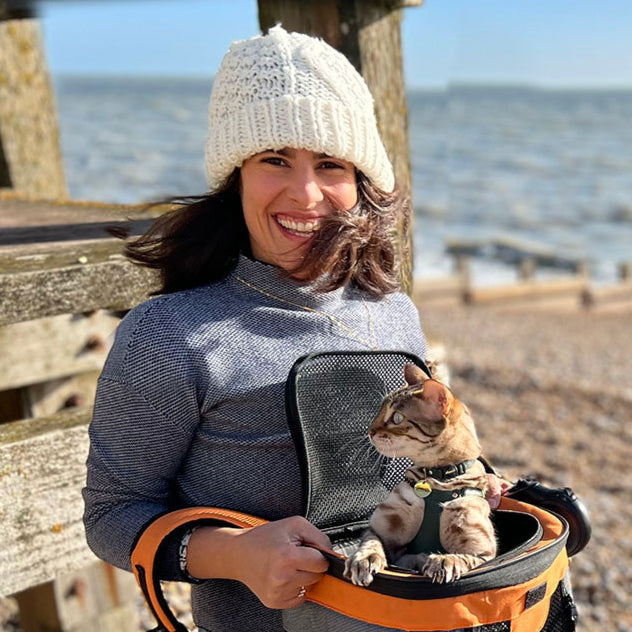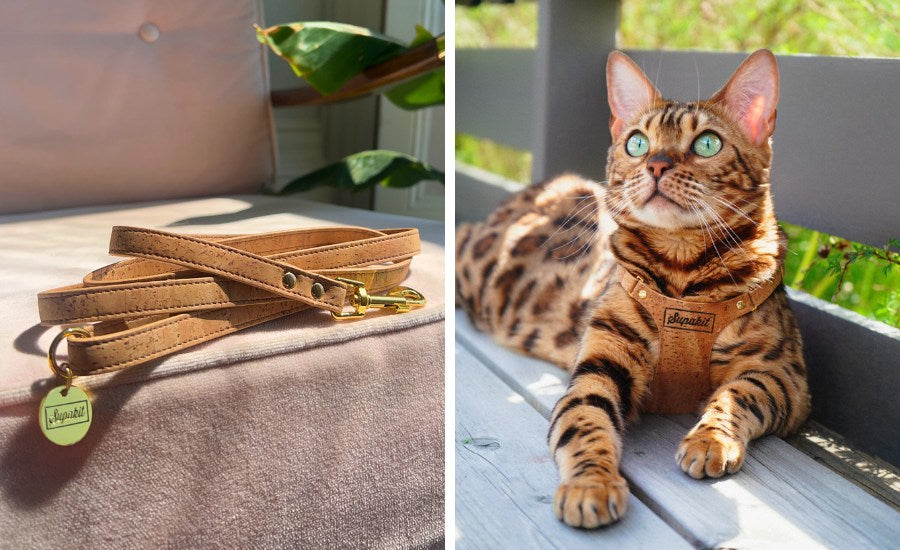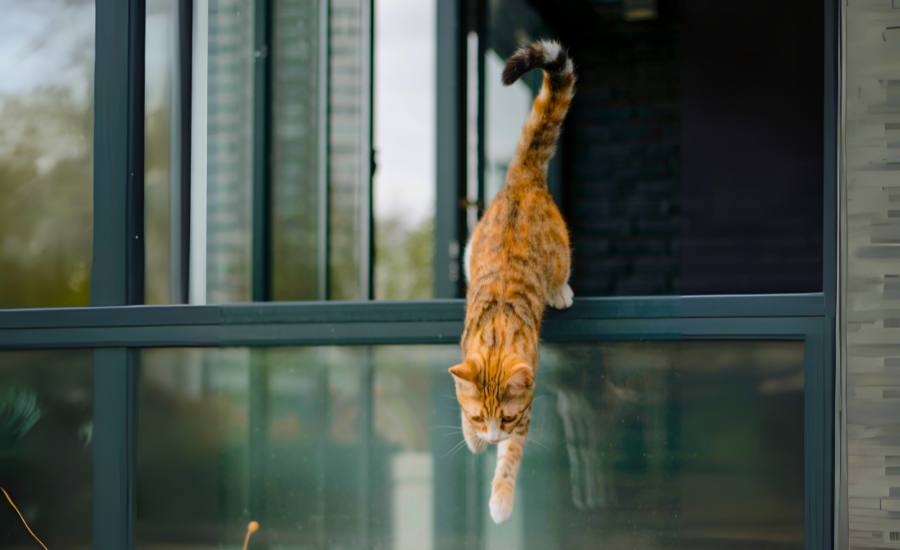How To Care For an Old Cat
Supakit co-founders, Leili and Kevin welcomed back Certified Cat Behaviour Consultant and Registered Veterinary Technician, Tabitha Kucera from @chirrupsandchatter to our monthly #catchat on Instagram Live to discuss how to care for senior cats and Tabitha gives us the wonderful news that an old cat really can learn new tricks!
Tabitha shares insightful and eyeopening tips on how to properly care for a senior cat and what to look out for as they age. Read on for the full #catchat - or, if you'd rather watch the video, head over to our IGTV channel here!

Q: So to start, how old is a senior cat?
Tabitha: Well, the American Association of Feline Practitioners considers 12 years old as a senior cat, but I personally consider a cat to be a senior at 7. That’s when we start noticing some physical and mental changes that might affect them. It might not necessarily affect every cat because each cat ages differently, just like humans. I’m on the alert from 7 years old onwards.
Q: What are those changes, what starts happening when a cat ages?
Tabitha: They have changes in their nutritional needs, hence why we have senior food. They have some skin and haircoat changes, you might notice with an old cat that their coat doesn’t seem as clean, you might notice more matting, they might not be grooming themselves as much. They also find change difficult. For example if you’re moving house, that transition might be a little harder for a 10 year old cat than for a 1 year old cat. We also see a decrease in mobility and similar to humans, they’re more predisposed to having medical issues. Arthritis for example, is really common in cats over the age of 7, based on the latest research over 80% of senior cats will suffer from it.
I call cats the ‘Silent Sufferers’. I probably see pain in around 60% of my cat consultations. People may say “But my cat is still jumping, how can they be in pain?”, but I still jump and my knees suck! A lot of my clients have no idea that their cat is as sick because they are as they are so good at hiding it. If they become withdrawn or have been hiding away, the chances are that their cat has been sick for some time, but they’re only now beginning to show obvious signs. So I try to teach my clients how to look out for those subtle cues.
Q: What are those signs to look out for so that we can identify any problems with our cat really early?
Tabitha: I recommend that elderly cats aged 7 and up go to the vets twice a year, because they’re more predisposed to health issues and if we catch it sooner, we can help them sooner and prevent things from getting worse. I also advise people to take videos of their cats acting ‘normal’, I believe every vet visit should include two to three minutes of videos showing your cat walking, playing and eating. Often when cats are in the vets consulting room, they’ll be in ‘fight or flight’ mode which will further mask any pain they’re experiencing. So by offering video footage of your cat in their natural environment, your vet will be able to better identify any problems they’re experiencing.
Something else to look out for is any behaviour change, even if it’s subtle. For example, my cats come to greet me at the door every day, if one of them suddenly stopped doing that I would wonder what was going on with them. In many cases, cats will show behaviour changes well before they start showing any symptoms of medical issues.
You may also notice changes in their movement. So for example, if my cat usually jumps straight up onto my desk while I’m working but then starts to jump on a box on the floor, then to the chair, then to the desk that might indicate they’re experiencing pain and are making the process of jumping easier for themselves.
You might also notice changes in their resting spots. If they used to jump to sit on top of the fridge but they haven’t done so in a year, this could be another indicator that they can’t manage activity that they used to. They’re very small changes but once you start to look out for them you may start to see a pattern. Keeping a journal of your cat’s behaviour is also a useful way to record these changes.
Related post: 'What Have You Always Wanted To Ask A Vet?
Q: Do senior cats still like to play?
Tabitha: I have five senior cats and they’re all very active. When I’m 70, I’m still going to be having brightly coloured hair, I’m still going to be jamming and playing – I might not be stagediving anymore, I might just hang out at a concert but I'll still like it! So for me, when I hear your cat isn’t playing at all, I would say they were experiencing pain somewhere – just because they’re old shouldn’t mean that they don’t want to play anymore!

Q: Are there any changes we should make to our home for a senior cat?
Tabitha: For ‘Super Seniors’ as I call them, which are cats over 15 years old, it’s very unlikely that they’re experiencing no pain at all. I like to ‘seniorfy’ their homes, just like you would do for an elderly relative in an assisted living home, you add things to your home to make their life easier and more comfortable. I used elevated bowls to make eating and drinking easier so they’re not bending down every time. Can you imagine bending over each time you wanted to have a drink of water?!
I also increase the amount of water available to them, I have water bowls on every floor in my house or near where they sleep so my senior cats don’t have to walk downstairs each time they need a drink. Can you imagine walking downstairs in the middle of the night just to get a drink? No – you’d just reach to your nightstand and grab your glass! There is a reason why we see so many kidney issues in old cats, because they’re not drinking enough so I want to make water as easily available to them as possible.
I also am a huge fan of nightlights for senior cats. I know we think cats are master hunters – which they are, but they get ageing changes to their eyes just like we do. I’ve dealt with cases where cats were missing their litterbox simply because they couldn’t see well enough to find it. Plug-in nightlights are great and help them find their resources easily.
Another thing I’m a huge fan of are low entrance, senior cat litter boxes. I use an under the bed storage container instead of a regular litterbox, they’re large and shallow. I sometimes even cut a lower entry point at the front of the box so older cats can step in really easily. The most common area where cats experience arthritis is in their coxal femoral joint around their backend which is used a lot when they go to the bathroom, so making it easier for them to step in their litterbox helps the whole process. Also, keep several litter trays around the house near where your cat sleeps, think of an elderly cat going downstairs to use the bathroom the same as your 90 year old grandmother doing so! Make it easier for them.
Q: Like humans, would you say old cats are wiser than younger cats? What’s the capacity of our senior cats to be smart and learn new things?
Tabitha: Old cats can learn new things really well. My cats all have a history of positive reinforcement training and clicker training but I didn’t start that until they were all seniors. They were seniors when I taught them how to wear harnesses, I have one cat that picks up things very quickly and one that takes slightly longer. I don’t think that it is necessarily an age thing, it’s more to do with the individual cat.
I’m a huge fan of clicker training in senior cats to help with cognitive disfunction, it’s that old saying of "use it or lose it", if you don’t provide your cat with lots of mental enrichment they will lose it! So things like puzzle toys and providing them with both horizontal and vertical scratch mats; senior cats might find that it hurts to scratch a vertical post. Clicker training is great because it allows cats with pain to stay still, you work with them for a couple of minutes a day and that is their mental enrichment! Scent enrichment is also great for old cats, you can put some silvervine or catnip in a paper bag or make them a snuffle mat which is used to place treats in and they use their nose to find them.
Q: Is there anything to do differently when clicker training a senior cat?
Tabitha: It’s the same process, so find treats your cat likes before you get started. Familiarise yourself with the clicker without your cat around, so by the time you start working with your cat you know how it works and can gauge timing better. If you just start randomly clicking at your cat, they’ll just get confused!

Q: Is clingyness common with old cats? Do they suffer from separation anxiety?
Tabitha: That definitely can happen. If it’s a new behaviour, that would ring bells with me and I would start to question if everything was ok medically. Senior cats do have more anxiety simply because life is harder for them. Many cats experience stress and we don’t normally notice it until it’s pretty severe. Separation anxiety in cats is a very real thing, it looks a little different in cats so it isn’t talked about as much. A stressed dog will destroy your stuff, a stressed cat might house soil but people don’t attribute it to stress.
I create enrichment schedules for my clients. Structure and predictability is really important to senior cats, so I suggest doing an activity with your cat such as playing with a toy before bed, an activity you do together. Then in the morning maybe put some silvervine in their cat tree or bring in some grass and twigs in from outside to investigate, which is something they can do by themselves. This gives them a clear indication of when they have time with you and when they can have time alone.
When I leave the house, I’ll take ten treats and leave them in the places my cat likes to rest. So they know when I leave the house, I’ll leave fun stuff for them to do. Eventually my cat will think ‘You’re leaving, great! You’ll leave fun stuff for me to do!’.
Q: Does a senior cat need more dental care? Should we be cleaning our cat's teeth?
Tabitha: Dental issues are the second most painful thing I see in cats. First - arthritis, second - dental pain. So, I’m a huge fan of brushing cats teeth. You should train teeth brushing so that they like it instead of holding them down and brushing their teeth, they won’t let you do that many times! Ten seconds on each side is usually enough to begin with, so it’s a very short process. Then you can build up, very slowly, to once a day for less than a minute.
Cat toothbrushes are available but I’m not a huge fan of those. There are small finger toothbrushes which can work but with my cats I use a piece of paper towel that acts like a gauze that I put over my finger, I put cat toothpaste on it and use my finger as the brush. I’m not getting bitten because we’ve worked up to my cat happily accepting me brushing their teeth.
You definitely don’t want to use human toothpaste, the fluoride in it is very bad for cats. Using cat specific toothpaste means they don’t have to rinse their mouth out, it’s specially designed to dissipate in their mouths.
To begin the toothbrushing training journey, find a couple of high value treats your cat loves, lickable treats are handy here. Those treats are then only used for toothbrush training, so they’re special. Then instead of approaching your cat with your hands out as though you’re going to grab their face, simply turn to their side and slowly put one hand out towards their face, each time you do so, give a treat. So; ‘hand out – treat’, ‘hand out – treat’ and so on. If your cat is actively retreating from you, don’t put your hand so close to their face but carry on the ‘hand out – treat’ process.
Once they become ok with that, move your hand closer each time until your cat allows you to touch their face and eventually begin to open their mouth by holding their lip back and rewarding with treats each time again. You can also have your cat lick a lickable treat off your finger and then begin to gently hold back their mouth at the same time. If you take 30 to 60 seconds per day to work on these steps you’ll soon be able to put your finger inside their mouth and rub once along their teeth using both lickable treats and cat toothpaste. As with all cat training we’re going at a pace your cat is comfortable with. If your cat averts their gaze or runs away, that probably means you’ve gone too far so go back a step and start from there.
You also don't need to worry about cleaning the inside of your cat's teeth, just stick to the outside, that makes it a little easier! If your cat has a lot of tartar or you see some lesions in their mouth then it’s likely they will need to have a professional teeth clean at your vets.
Related post: 'Cat Teeth - Your Top 10 Questions Answered'

Q: What would you recommend in a case where a senior cat has started to meow a lot and has become more vocal, is this a cause for concern?
Tabitha: The first thing I think of with a vocal senior cat, especially if it’s in the middle of the night, is that it’s usually a sign of some cognitive disfunction. That could mean some brain changes, we use the acronym DISHA:
Disorientation - Your cat might be meowing behind a door, usually they could find their way out but this time they can’t. They’re meowing at a wall or into space.
Interaction – Is your cat interacting with you more? Are they more withdrawn? Are they now not enjoying the company of other cats in your home?
Sleep – Is your cat up at 3am meowing when they didn’t before?
House soiling – They might be forgetting where their litterbox is.
Activity – We tend to see decreased activity.
Even if your cat is displaying one of these changes in behaviour, it’s definitely something to bring up with your vet.
But something you could try at home to help with excessive meowing from boredom is increasing enrichment. Introduce really easy food and treat puzzle toys that they can easily play with without moving a lot. Simply placing treats in their favourite resting place before you go to bed becomes a consistent, predictable thing for your cat which indicates that it’s bedtime and also allows your cat to hunt in the middle of the night.
So, as a takeway the three easy go-to points to help out all senior cats would be; 1. Consistency and predictability 2. Increasing enrichment and 3. Increasing resources, so more water bowls, more easy access senior cat litter boxes near to where they sleep.
We hope you found Tabitha’s advice on caring for senior cats as insightful and helpful as we did. Head over to Tabitha’s website www.chirrupsandchatter.com or check her out over on Instagram @chirrupsandchatter
Related post: 'How To Keep Your Cat Happy Outside - Tabitha Kucera'







